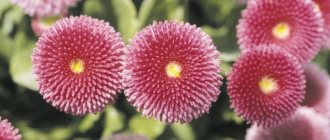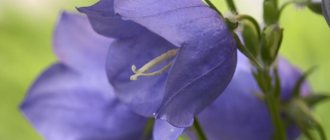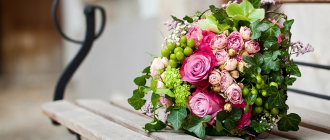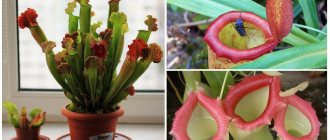Fuchsia indoor flower - plant varieties
Sometimes, when hearing the word “fuchsia”, a person imagines a bright shade of pink. However, this is not entirely justified. Fuchsia is primarily a plant; depending on the species, it has flowers from white to purple shades. Fuchsia is an indoor flower. Multi-colored unusual buds are not interesting for bees. For this reason, the plant is pollinated by small hummingbirds. The pollen sticks to their beaks thanks to a special sticky substance secreted by the flower. Other interesting features of the plant are below in the article.
Description of the plant
Fuchsia belongs to the genus Onagricaceae, which has 100 species. Among them are shrubs, trees and hanging varieties. South America is home to the first representatives of this species. The flower was first discovered in 1696. The name was received in honor of the botanist Fuchs, who studied this species.
What does a fuchsia flower look like?
Fuchsia blooms very beautifully. The flower is a drooping bell with an upper border that is significantly different from the main shade. Inside the bell there are eight very long stamens. Above it is a four-lobed sepal.
Indoor fuchsia is called gracilis. Mexico is considered its homeland. Under natural conditions, this plant is presented in the form of a shrub. At home, it grows no more than 70 cm. It has dark green or green leaves. Flowers with long pedicels and axils. The heads are down.
There are inflorescences collected in a brush; they are characterized by bright colors, as well as with double colors. Depending on the genus, flowers are simple, double or semi-double. Flowering is characterized by a long duration. Hybrid varieties are common at home. Flowering begins in spring and ends in autumn.
TOP 10 best fuchsia varieties
Heuchera hybrid: description, best varieties
Chinese lanterns are very popular both among professional gardeners and amateur gardeners. In addition to the fact that fuchsia has a wide variety of varieties, it is unpretentious and looks great.
Fuchsia
Note! Every year, Russian and foreign breeders develop several new species of elf flowers.
The best modern varieties are:
| Variety name | Plant height, type of shoots | Description of flowers | Description of leaves | Method of cultivation, what the plant is used for |
| Bolivian | Up to 1 m | Large, dark red or white. | Ovoid in shape, slightly pointed at the tip. Length less than 15 cm, width 0.5 cm. Velvety to the touch. | Indoor floriculture |
| Collected in clusters with peduncles about 30 cm. | ||||
| Thin or graceful | Up to 3 m | Light purple or violet on long and thin stalks, collected in racemes. | Lanceolate with a finely toothed edge, attached to long, red petioles. | Flower beds and flower beds |
| Thin with pubescence, reddish in color. | ||||
| Brilliant | Up to 2 m | Bright crimson with a crimson tint. | Large, oval with jagged edges, purple-green. | Flower beds and flower beds |
| Reddish thin, flexible. | Collected in hanging clusters, collected at the top of the plant. | |||
| Three-leaved | Up to 0.5 m | Bright red, collected in brushes. | Ovate-oblong. The upper side is reddish-green and the underside is brownish-red. There is fluff along the veins. | Creation of decorations and exhibitions |
| Covered with short hairs. | ||||
| Magellan | Up to 3 m | Collected in inflorescences. | Purple, about 4 cm in size with fluff along the veins. | For decorating window openings and walls |
| Recumbent | Up to 1 m | Single rose-red or orange without petals. | Small, round, on long petioles. | Decoration of balconies and loggias |
| Sparkling | Up to 2 m | Scarlet red. After flowering, edible berries are formed, collected in clusters. | Large, jagged. | Creating flower arrangements |
| Splendence | Up to 2 m | In the shape of a long and red tube with greenish petals. The fruits have a lemon flavor. | Long (up to 20 cm) pointed at the tips. | Creating flower arrangements |
| Thyroid | Up to 3 m | Pink, violet, purple long and thin, collected in brushes. | The same as sparkling fuchsia. | To create flower arrangements |
| Bright red | Up to 1 m | Bright red with purple accents. | Oval, on short petioles. | Indoor floriculture |
| Thin. |
Reviews of the best fuchsia varieties are constantly updated.
Superstition about a flower
Fuchsia is a common flower. Once in the house, it becomes its decoration. She is credited with magical properties. The plant is not too picky, but requires special care. Loves moist soil. Watering should be organized so that the soil is always slightly moist. The main thing is not to over-moisten. In this case, negative consequences are possible, including the death of the plant.
Overdrying the soil also has negative consequences. In this case, the leaves fall off and the formation of flower stalks stops. There are some tips for proper plant care:
- if the leaves begin to become covered with brownish-yellow spots, then watering should be interrupted and wait until the soil dries;
- if the plant has withered and the soil is wet, then it needs to be moved to a sunnier place;
- the flower really likes washing and spray treatment.
It is useful to have this kind of plant for creative people. It gives them inspiration and fills them with energy. It grows and emits special energy.
In a house where representatives of several generations live, mutual understanding and prosperity will reign. The love that a person gives to this flower multiplies and returns to him in the form of an increase in inner beauty and charm.
For your information! In addition to all the positive qualities, fuchsia is considered a flower whose owner in most cases is a single woman. Many gardeners call fuchsia a widow's flower.
Insect pests and measures to combat them
All fuchsia varieties can be damaged by the following parasites:
- Greenhouse aphids. A small pale green insect sucks juice from young leaves. To destroy the pest, all surfaces in the greenhouse are washed with hot water with liquid potassium soap and actellik dissolved in it.
- Whitefly. The insect has a pair of wings and is capable of jumping and flying. Whitefly larvae suck sap from young stems and leaves. They destroy the pest with drugs that can be purchased in specialized stores.
- Spider mite. A tiny reddish insect covers the shoots and leaves with a mesh of the finest cobwebs, where it breeds its offspring. To eliminate the disaster, the plant is washed with hot soapy water or treated with special preparations.
Popular varieties
There are a large number of species and subspecies of this representative that can be grown in the Russian climate.
Fuchsia Annabelle
Refers to ampelous species. Characterized by abundant, long-lasting flowering. It has an average height of up to 40 cm. The flowers are large and double white. It is considered a white princess who can decorate any home or garden.
Fuchsia Voodoo
It has a very beautiful color, contrasting and bright. The skirt is dark purple, the sepals are intense red. Heart-shaped buds. It grows very quickly from the shoot and becomes a powerful plant. It blooms quite profusely. Voodoo is unpretentious and upright.
Fuchsia Ballerina
The variety is a classic representative of this genus. It is a self-branching bush. It has large, densely double peduncles that resemble a ballerina's tutu. Bred in England in 1894. Associated with childhood memories.
Fuchsia Marinka
Characterized by bright red sepals. The variety has simple dense flowers. The variety is distributed throughout the country. It is an ampelous variety. Blooms profusely. The bush is bright and lush.
Fuchsia Swingtime
Characterized by flowers with deep red sepals. The flower itself is white, the peduncles are double and thick. The variety has a long flowering period. It belongs to the bush representatives, but is described in the literature as a semi-ampelous subspecies. You can form an ampel.
Fuchsia Millennium
A very bright representative of the Fuchsia genus. It has a black cherry skirt and bright red sepals. The flowers are particularly large and terry. The bush reaches a height of up to 40 cm. Reproduction occurs by cuttings. The cuttings take root very well. The flowering plant looks exotic and attractive.
Fuchsia Dark Eyes
A very contrasting variety. The skirt is purple, decorated with bright pink sepals. Belongs to semi-hanging varieties. Has an average flowering time. The flowers are large and double. Recommended for growing in hanging pots. Reaches a height of up to 23 cm.
Fuchsia Natasha Sinton
Delicate attractive flower. It has a rich pink hue, which gives it a special charm. The flowers are large and double, looking like little angels. Characterized by a long flowering period. Refers to ampelous varieties.
Fuchsia Deep Purple
A very contrasting, charming variety. The skirt is purple, decorated with white sepals. Belongs to semi-hanging varieties. Has an average flowering time. The flowers are large and double. Recommended for growing in hanging pots.
Fuchsia Peachy
Refers to semi-ampel varieties. A very extravagant flower with a terry skirt of a cool pink shade, decorated with white sepals. The flowers are characterized by their particularly large size.
For your information! It has a long flowering period, during which the shade of the peduncle changes from pink to peach-salmon.
Fuchsia Lenny Erwin
Belongs to the ampelous variety. It has a light purple skirt and white sepals. The flowers are large in size and double, reminiscent of a rose flower. Reaches a height of up to 40 cm, has a bushy growth form. Reproduction occurs by cuttings. The cuttings take root very well.
Fuchsia Pink Marshmallow
The flowers are delicate and attractive. They look like little cupids. Characterized by increased terry and soft pink color. The variety will decorate any home. Has an average flowering time. Suitable for growing in hanging pots. Reaches a height of 25 cm.
Fuchsia El Camino
It belongs to the semi-ampelic varieties and is self-branching. Reaches a height of up to 30 cm. Flowering is early and long-lasting. The skirt has a white color and rich veining. Sepals are red. The flowers are large in size and double.
Fuchsia Gillian Althea
Belongs to the bush type of plants. The variety is contrasting and fits harmoniously into any interior. Attracts attention with its unusual colors. Blooms profusely and for a long time. Reaches a height of up to 50 cm. It is considered tall.
Fuchsia Royal Mosaic
Looks very specific. Has large purple flowers. The plant of this variety has fast growth and late flowering. Peduncles are very large. Has an average flowering time. Suitable for growing in hanging pots. Reaches a height of 25 cm.
Fuchsia Rocket Fire
Belongs to the bush type. It has a peculiar coloring of peduncles, which is characterized by a combination of purple and blue colors. Sepals are deep pink. The buds have a large elongated shape. The leaves are light green. He is one of the giants of his species.
Fuchsia Blacky
Belongs to the giant variety. Flowering is characterized by a large number of peduncles, which is twice as many as in conventional varieties. The sepals have a dark red tint, the bell itself is purple-black. Recommended for growing in hanging baskets. Reaches a height of up to 30 cm. This fuchsia is a hybrid.
Fuchsia Unusual
Belongs to the bush type. It has round peduncles of a soft pink hue. Characterized by abundant, long-lasting flowering. It has an average height of up to 40 cm. The flowers are large and double.
Fuchsia Water Nymph
It has red petals and pale pink sepals. This contrast gives a special piquancy and attractiveness. It blooms abundantly throughout the summer. Belongs to the bushy, vigorous type.
Fuchsia White King
It is one of the largest-flowered varieties with white flowers. Has double peduncles. Refers to the bush form. Flowers of this variety look attractive in any interior. It has large leaves that look especially extravagant on a large bush. Tolerates elevated air temperatures well.
What does fuchsia look like?
Varietal characteristics determine which flowering part of the plant will be - double or simple. Both double fuchsia and simple fuchsia have one peculiarity - their original flowers look like tiny dancers in fluffy skirts of various shades. Therefore, flower growers call the plant Japanese or Chinese lantern and elf flower. And in common parlance you can find the name gypsy earrings. Fuchsia also bears this name due to the presence of bright curved petals on each flower.
Important! An ornamental shrub can delight people with its flowering for a very long time. In some varieties, after the flowers fall, juicy berries-fruits are formed.
FUCHSIA. We save until spring. Secrets of proper maintenance in winter
Fuchsia has long been known to floriculture lovers. Our grandmothers also enjoyed decorating their window sills with it, and in the summer their gardens, terraces, and gazebos. Now many beautiful varieties have been bred and interest in this flower is constantly growing. Although this plant is suitable even for novice gardeners, for successful growth and long flowering, proper care and maintenance must be provided.
1. When placing, keep in mind that the plant does not like bright sunlight. East or north windows would be ideal. High air temperatures are also poorly tolerated. Therefore, in the warm season, it is better to take your pet out into the garden or onto an open balcony. It can be placed in the shade, in hanging flowerpots or planted in open ground.
2. Any loose mixture for flowering plants is suitable as a substrate. You can add a little chopped sphagnum moss and leaf humus (a teaspoon per pot). Before use, I recommend calcining garden soil in the oven and pouring potassium permanganate on it.
3. I recommend planting the flower in a ceramic container with thick walls in order to avoid overheating of the root system.
4. For irrigation, use well-settled, warm water, rain if possible. In summer, try not to let the earthen ball dry out. Spraying the leaves is also necessary. The quality and duration of flowering depends on this. With a lack of moisture, fuchsia may drop its buds and not open. In winter, on the contrary, watering is reduced, brought to 2 - 3 times a month.
5. Regular feeding, mineral and organic, is required. It is very good to alternate root and foliar feeding. In the warm months, as soon as the buds appear, fertilize every week, and from October, reduce and stop completely in winter.
6. Fuchsia is susceptible to attacks by whiteflies and spider mites. If found, immediately wash the leaves and spill them with soapy water. Next, treat with a special preparation. Repeat this procedure after a week. In the future, for prevention, use a solution of nettle and garlic.
For successful growth and even for preserving the specimen in winter, proper maintenance is important. Try to ensure the air temperature is up to 15 degrees. A decrease to +5 degrees is not dangerous for the flower. I noticed that with colder wintering, the plant becomes stronger and blooms more abundantly and more readily.
During this period, the plant needs pruning. For my pets, I carry out this procedure boldly, leaving 10–15 cm of the stem. Periodically cut off the awakened thin shoots. Sometimes buds may appear; be sure to remove them, otherwise there will be no lush flowering in the spring.
It's better not to worry about watering. This is done as rarely and as little as possible. From autumn to spring, the “dancing ballerina” sleeps and it is not advisable to disturb her.
Many people advise cleaning fuchsia pots in a dark basement over the winter. It didn’t work out for me, the flower simply died, so they are on an ordinary windowsill, close to the window glass. I try to open the window or do micro ventilation whenever possible.
I hope that many will like this beauty!
Subscribe to my channel, like and share your favorite posts with your friends!
Fuchsia - Fuchsia
Tips for caring for fuchsia
Fuchsia - Fuchsia
Posted April 5, 2012, 01:24 pm
Fuchsia (Fuchsia) of the fireweed family (Onagraceae) is an evergreen deciduous shrub with beautiful drooping flowers. Distributed wild in the subtropical and tropical regions of Central and South America, New Zealand and Polynesia. Fuchsia was developed in 1695 by the French botanist Charles Plumière. He named the new plant after the German botanist and doctor Leonhart Fuchs. Later, the scientist developed more than 100 varieties of this plant. The fuchsia flower is also called “ballerina” - for its charming flowers in “ballet tutus”. Fuchsia is quite simple to grow and not particularly demanding. Fuchsias, depending on the type, are shrubby, treelike (in natural growth conditions) or carpet. The long-petiolate green leaves with strongly depressed veins are oval in shape, jagged at the edges, located oppositely on the stems, less often collected in whorls. Young stems and petioles are reddish in color. The flowers are solitary or collected in racemes, axillary, on thin stalks, drooping. They consist of a tubular calyx with four pointed, far reflexed sepals and a bell-shaped corolla, which can be simple, semi-double or double. The stamens and pistil hang from under the corolla-skirt. The flowers have a range of colors - white, pink, red, purple. There are varieties with double coloring. Blooms for a long time and abundantly.
I would like to note that in the homeland of fuchsias (America, New Zealand, Tahiti), this plant, in addition to beautiful flowers, also produces very tasty berries. It is unlikely that you will be able to get berries under indoor conditions, but, nevertheless, indoor fuchsia is a completely edible plant! So you can safely decorate desserts with fresh fuchsia flowers.
Fuchsia care
First of all, clearly decide on the place in the house where you will place your fuchsia. It is very important. The fact is that the fuchsia flower really doesn’t like being rearranged and turned, this can cause the flowers to drop (by analogy with the Decembrist, for example). The place where the fuchsia is kept should be sufficiently lit. Fuchsia loves bright, diffused light, but without direct sunlight. It should be noted that sunlight is not at all necessary for fuchsia; it develops well under artificial light. For this you can use ordinary fluorescent lamps. With a lack of light, fuchsia stretches out and does not bloom.
The temperature of fuchsia in summer is normal room temperature (18-20 degrees). But summer heat, which has become common in recent years, is dangerous for fuchsia. If possible, take the fuchsia flower out into the fresh air in the summer. In winter, fuchsia definitely needs a lower temperature (8-10 degrees). And this is perhaps the only difficulty that a city dweller may encounter. But this is a completely solvable problem. Many housewives successfully grow fuchsias in the kitchen, where they overwinter beautifully. And this is not nonsense, read “Temperature for indoor plants” and “Plants in the heat”, I hope these tips will help you. be watered regularly and abundantly in the summer and moderately, but just as regularly, in the winter. But! Regular and abundant watering does not mean that the plant needs to be flooded! Fuchsia should be watered only after the soil has dried. Indoor fuchsia is a plant that loves high air humidity, so watering can (and should) be alternated with spraying and washing. Let me remind you that water for irrigation and spraying should be well settled and at room temperature.
Fertilizing fuchsia must be taken seriously. Without receiving the proper amount of necessary microelements, fuchsia is unlikely to bloom normally. But, as with everything, when using fertilizers you need to know when to stop. By overfeeding fuchsia, you can get a lush green mass and a couple of stunted flowers. Therefore, it should be fertilized once every two weeks with a well-balanced fertilizer for flowering plants (fertilizer for pelargoniums gives good results); you can use Kemira, Peters and the like. In winter, stop fertilizing. Full care for fuchsia is unthinkable without regular pruning. Pruning fuchsia will not only make your plant more beautiful, but also stronger and healthier. “Pruning” is not quite the correct term in this case; fuchsia shoots must be pinched. Pinching begins at the stage of a recently rooted cutting and continues throughout the life of the plant. It is best to do pinching in the spring, before the fuchsia blooms. To get a beautiful bush, pinch all the side branches after about 3-4 pairs of leaves. To get an ampelous (hanging) look, you can choose your own method. But even in this you need to know when to stop, don’t get too carried away, let the shoots grow. replanted mainly as needed, when the roots in the pot become crowded (they climb out through the drainage holes). The rules for selecting a pot when replanting for fuchsia are the same as for most plants. Good drainage is very important, which will prevent the soil from stagnating. You can buy ready-made soil for replanting fuchsia, or you can prepare it yourself, which is preferable. To do this, you need to take one part of peat, compost soil, humus soil and mix with two parts of coarse sand. For good flowering, you can add a little bone or horn meal (a tablespoon per liter of mixture).
Fuchsia Natasha Sinton and others in the metro station Dybenko Street
- Address: St. Petersburg, metro station Dybenko Street
Small well-rooted fuchsia cuttings are sold for 120 rubles. I root and grow it myself. - Natasha Sinton - Semi-pellet form. The buds are large, round. The sepals are white with green tips. The skirt is light pink. The flowers are double and large. Delicate variety! -Cecile-The buds are large and round. Sepals are red-pink with green tips. The skirt is a rich lavender blue, with a thin silver border, and pink at the base. The flowers are densely double, very large and dense. -Thalia -Large velvety dark green leaves with a reddish tint, with red petioles and veins, give the plant a special decorative appearance. He loves to bask in the sun. Winters well.-Blue Angel- Blue Angel Semi-ampelic (height 30-40 cm) fuchsia with very early, abundant, long-lasting flowering. Large double flowers. The skirt is blue with a pink coating at the base of the petals. Cuttings of this variety take root quickly and easily. Fast growth. Not afraid of the sun.Beacon-Rosa A bush variety, compact and well branched. The flower is single, bell-shaped, and the small teeth along the edges of the petals give it a special charm. The plant is quite unpretentious - conditionally Violetkoningin There are varieties whose origin is unknown, but they have become part of the culture so firmly and long ago that international databases and search engines for fuchsias have to take this into account. This is Violetkoningin - the purple queen - this is how the name of this strong variety is translated from Dutch - Windhapper - An abundantly flowering ampelous variety with spectacular flowers of a complex bell-shaped form with sepals-curls, which is deservedly loved by gardeners. In July 1991, he was awarded the VKC - Permanent Judicial Commission of the Netherlands-Angelika-Fuhrmann - 170 rubles. young plant in a pot There are about 40 varieties of fuchsias in the collection; I periodically replenish the sales album with various varieties. A more complete list of plants for sale and their appearance can be found on my page on VKontakte Makushina (Lisogurskaya) Svetlana. Place your order when you are ready to purchase in the coming week. You can pick up plants - St. Petersburg, metro station Dybenko street. Delivery to your address is possible in the city (for orders over 1200 rubles. The delivery amount is negotiated separately). KIROVSK, SINYAVINO 1 -2, PRILADOGSKY, SHLISSELBURG, (delivery of plants to the entrance to these suburbs is free, when ordering over 300 rubles), as well as Len. region, 53 km. Murmansk highway, Sinyavino 2
Unfortunately, this advertisement is no longer relevant. You can see similar current advertisements from the current category a little lower, or go to the category using the link: Ornamental trees, shrubs and flowers (seedlings and adult plants) in the city of St. Petersburg. You can also use the site search form.
The private forest nursery offers you trees and shrubs characteristic of the North-West, seedlings and seedlings of coniferous and deciduous trees grown in local conditions (Leningrad region).
city of St. Petersburg - Ornamental trees, shrubs and flowers (seedlings and adult plants)
In photo 1, ixora is in bloom, in photo 2, ixora is sold at a price of 300 rubles. In photo 3, stephanotis or Madagascar jasmine is priced at 200 rubles.
city of St. Petersburg - Ornamental trees, shrubs and flowers (seedlings and adult plants)
Young violets, lilac, double blooming and with buds, 50-70 rubles for a blooming violet in a pot. There are very large ones - for 100 rubles. Total.
city of St. Petersburg - Ornamental trees, shrubs and flowers (seedlings and adult plants)
I will take cuttings from a young plant in front of you. It blooms with very delicate and fragrant white flowers. It grows quickly and is unpretentious. Prazhskaya 3 metro Bukharestskaya
city of St. Petersburg - Ornamental trees, shrubs and flowers (seedlings and adult plants)
city of St. Petersburg - Ornamental trees, shrubs and flowers (seedlings and adult plants)
Dry lavender Harvest 2022 Up to 3 bunches - 250 rubles / bunch From 4 to 10 bunches - 200 rubles / bunch From 11 bunches - 170 rubles / bunch A bunch of 180-200 branches (35g).
city of St. Petersburg - Ornamental trees, shrubs and flowers (seedlings and adult plants)
I sell surplus ferns. Fast growing Nephrolepis. All plants only after transplantation. Photo 1-2 large with a span of 60 cm in a new white pot with automatic watering 400 rubles, without a pot it will be 160 rubles.
city of St. Petersburg - Ornamental trees, shrubs and flowers (seedlings and adult plants)
violet - double lilac flowers, pot size - 10 cm, together with flower - 22 cm. Price - 100 rub. Possible together with a flowerpot (hanging + 150 RUR)
city of St. Petersburg - Ornamental trees, shrubs and flowers (seedlings and adult plants)
I will sell grown cuttings of varietal pelargoniums: Yu_Bolero-300, Toscano Burns-300, ODENSJO BLACK MAMBA-700, Yu_Lilac Fog -2500, Yug Princess Grace 3500, Graingers Antique Rose - 1700, OCH-Madpearl Rose-4000, South African Sun-300.
Varietal types of fuchsias (description)
In floriculture, there are about one hundred species of fuchsias. In cultural gardening, varieties and hybrids obtained from them are used. Today there are about twenty thousand varieties and hybrids of this beautiful plant. Their number continues to increase.
- Fuchsia Basseveldse Ezels with dense double inflorescences, grows in the form of a bush, has rounded buds of inflorescences with a white-pink combination of sepals on the inside with a cherry tint coating. The skirt of the flower is bright red.
Fuchsia flowers Basseveldse Ezels: photo - Fuchsia Bicentennial. A unique varietal hanging plant with large elongated salmon-colored buds. The flower is framed by a red terry skirt with peach-colored strokes. The blossoming flower changes color, becoming orange.
Fuchsia Bicentennial flowers: photo - Bolivian Fuchsia. A tall bush variety about one meter high with very large flowers collected in hanging clusters. The plant is designed for growing in a warm room and does not respond well to low temperatures. The flowering period occurs in March-April.
Bolivian fuchsia flowers: photo - Fuchsia Lenny Erwin. The plant has an ampelous shape, blooms with large double flowers with white sepals with green tips. The fluffy skirt of the flower is lilac in color. The form of the variety is ampelous.
Fuchsia flowers Lenny Erwin: photo











